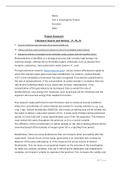Name:
Unit 6: Investigative Project
Accessor:
Date:
Project Research
Literature Search and Review – P1, M1, D1
P1 - Carry out a literature search and review into a chosen scientific area.
M1 - Analyse a literature search and discuss its relevance to inform the investigative project proposal.
D1 - Evaluate the methods of investigation for the investigative project proposal, justify the hypothesis chosen.
Photosynthesis is identified as a biological process that converts light energy into
chemical energy, utilising this to formulate organic molecules, such as glucose from
inorganic substances, more particularly water (Joanne. H. 2016).
Through extensive research (https://edu.rsc.org/) various factors affecting the speed at
which this reaction takes place have been established. For instance, Carbon Dioxide
(CO2) in the immediate environment has been recognised to be directly proportional to
the rate of photosynthesis. If the concentration of carbon dioxide is increased, then the
rate at which photosynthesis occurs would also increase. Subsequently, if the
concentration of this gas where to be decreased, then so would the rate of
photosynthesis. Less energy-rich molecules, such as glucose will be composed and the
organism will have less energy than needed to function.
One research study performed to test this theory was to construct several conditions
where the concentration of carbon dioxide was existent in varying volumes (0.2 g, 0.4g,
0.6g, 0.8g). Sodium bicarbonate (NaHCO3), also known as baking soda will be infused into
the water to deliver a saturated solution of CO2. A water plant (Elodea) will be positioned
upside in a test-tube with a lamp approximately 30cm3 from the apparatus. This distance
must remain the same throughout the practical, as it is a control variable.
The efficiency of the concentration of carbon dioxide on the rate of photosynthesis will be
examined based off the bubbles of oxygen given off in a specified time period.
Nonetheless, there are some hinderances that can transpire when proceeding with this
experiment. Human errors can be made, particularly if an individual fails to keep the
distance of the lamp undeviating, or if the measure the wrong volume of Sodium
Bicarbonate. This can leave an exceptional impact on the outcome of the investigation.
As these are constant variables, they aid in affirming the dependent and independent
variables, and makes it simpler to reproduce the practical. This increases the validity and
1|Page
, reliability of the investigation. Furthermore, creating inaccuracies within the control
variables can lead to the formation of Confounding Variables (Anne Marie Helmenstine.
Jan.2020). Recognised as an additional variable that was not accounted for, cofounding
variables act as an outside influence to recondition the effects of the dependent and
independent variables, resulting in invalid data attained.
As enzymes as involved in nearly all metabolic reactions in order to speed up the rate of
reactions that transpire in living organisms (www.ck12.org.), one underlying factor that
can affect these biological catalysts is the temperature. If the temperature where to
become too low, the number of successful collisions between the substrate and the
enzyme will be decreased. The Collision Theory states that for chemical reactions to
occur, the reactants must collide with an energy greater than or equal to the activation
energy.
The activation energy is the minimum energy required for the collisions to break the
bonds in the reactants and lead to a reaction (Frances. A. 2016).
This cannot happen at low a temperature, so the rate of photosynthesis will be
decreased. However, if the temperature were to become too high, the enzymes would
start to denature. The heat energy would break the hydrogen bonds that hold the
secondary and tertiary structure of the enzyme together. The enzymes would lose its
shape, and the substrate will no longer fit into the active site. The process of
photosynthesis cannot be catalysed, and therefore the rate of photosynthesis would
decrease.
A method (https://biology-igcse.weebly.com/) to test this can be done by carrying out five
trials where each water plant is left in a test-tube of varying water temperatures. (25oC,
30oC, 35 oC, 40 oC 45 oC). Excess sodium bicarbonate (NaHCO3) will be placed inserted into the
water and a lamp will be placed at a fixed distance, both of these acting as a constant
variable. The productiveness of each temperature will be measured by the number of
bubbles produced at a predetermined time-period.
However, there are some complications that can occur when undertaking this practical.
The light source can cause misconstrued results, as it can un-intentionally release heat
through the conversion of its light energy, increasing the temperature, leading to the
attaining of higher results. Additionally, if the room temperature is not kept is not kept at
a constant of 20oC, then both these factors can make the data retained invalid. The test-
tube creates a tight surface-area, thus one may find difficulty in counting the bubbles as
it may be hard to see. Consequently, the data retained may be invalid.
Light Intensity was also found to be directly proportional to the rate of photosynthesis. As
the intensity of light is augmented, the specialised guard cells in the interior of the plant
2|Page




